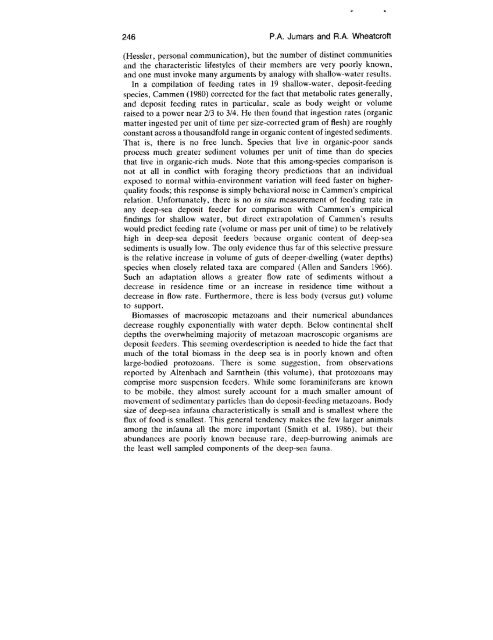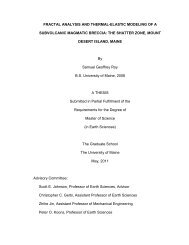Responses of Benthos to Changing Food Quality and Quantity, with ...
Responses of Benthos to Changing Food Quality and Quantity, with ...
Responses of Benthos to Changing Food Quality and Quantity, with ...
You also want an ePaper? Increase the reach of your titles
YUMPU automatically turns print PDFs into web optimized ePapers that Google loves.
246 P .A . Jumars <strong>and</strong> R .A . Wheatcr<strong>of</strong>t<br />
(Hessler, personal communication), but the number <strong>of</strong> distinct communities<br />
<strong>and</strong> the characteristic lifestyles <strong>of</strong> their members are very poorly known,<br />
<strong>and</strong> one must invoke many arguments by analogy <strong>with</strong> shallow-water results .<br />
In a compilation <strong>of</strong> feeding rates in 19 shallow-water, deposit-feeding<br />
species, Cammen (1980) corrected for the fact that metabolic rates generally,<br />
<strong>and</strong> deposit feeding rates in particular, scale as body weight or volume<br />
raised <strong>to</strong> a power near 2/3 <strong>to</strong> 3/4 . He then found that ingestion rates (organic<br />
matter ingested per unit <strong>of</strong> time per size-corrected gram <strong>of</strong> flesh) are roughly<br />
constant across a thous<strong>and</strong>fold range in organic content <strong>of</strong> ingested sediments .<br />
That is, there is no free lunch . Species that live in organic-poor s<strong>and</strong>s<br />
process much greater sediment volumes per unit <strong>of</strong> time than do species<br />
that live in organic-rich muds . Note that this among-species comparison is<br />
not at all in conflict <strong>with</strong> foraging theory predictions that an individual<br />
exposed <strong>to</strong> normal <strong>with</strong>in-environment variation will feed faster on higherquality<br />
foods ; this response is simply behavioral noise in Cammen's empirical<br />
relation . Unfortunately, there is no in situ measurement <strong>of</strong> feeding rate in<br />
any deep-sea deposit feeder for comparison <strong>with</strong> Cammen's empirical<br />
findings for shallow water, but direct extrapolation <strong>of</strong> Cammen's results<br />
would predict feeding rate (volume or mass per unit <strong>of</strong> time) <strong>to</strong> be relatively<br />
high in deep-sea deposit feeders because organic content <strong>of</strong> deep-sea<br />
sediments is usually low . The only evidence thus far <strong>of</strong> this selective pressure<br />
is the relative increase in volume <strong>of</strong> guts <strong>of</strong> deeper-dwelling (water depths)<br />
species when closely related taxa are compared (Allen <strong>and</strong> S<strong>and</strong>ers 1966) .<br />
Such an adaptation allows a greater flow rate <strong>of</strong> sediments <strong>with</strong>out a<br />
decrease in residence time or an increase in residence time <strong>with</strong>out a<br />
decrease in flow rate . Furthermore, there is less body (versus gut) volume<br />
<strong>to</strong> support .<br />
Biomasses <strong>of</strong> macroscopic metazoans <strong>and</strong> their numerical abundances<br />
decrease roughly exponentially <strong>with</strong> water depth . Below continental shelf<br />
depths the overwhelming majority <strong>of</strong> metazoan macroscopic organisms are<br />
deposit feeders . This seeming overdescription is needed <strong>to</strong> hide the fact that<br />
much <strong>of</strong> the <strong>to</strong>tal biomass in the deep sea is in poorly known <strong>and</strong> <strong>of</strong>ten<br />
large-bodied pro<strong>to</strong>zoans . There is some suggestion, from observations<br />
reported by Altenbach <strong>and</strong> Sarnthein (this volume), that pro<strong>to</strong>zoans may<br />
comprise more suspension feeders . While some foraminiferans are known<br />
<strong>to</strong> be mobile, they almost surely account for a much smaller amount <strong>of</strong><br />
movement <strong>of</strong> sedimentary particles than do deposit-feeding metazoans . Body<br />
size <strong>of</strong> deep-sea infauna characteristically is small <strong>and</strong> is smallest where the<br />
flux <strong>of</strong> food is smallest . This general tendency makes the few larger animals<br />
among the infauna all the more important (Smith et al . 1986), but their<br />
abundances are poorly known because rare, deep-burrowing animals are<br />
the least well sampled components <strong>of</strong> the deep-sea fauna .
















